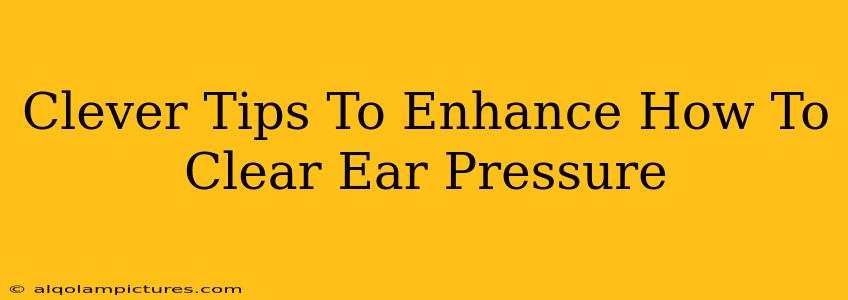Experiencing that uncomfortable, plugged feeling in your ears? Ear pressure, also known as aural fullness, is a common issue that can stem from various causes, from altitude changes to colds. While a doctor's visit is always recommended for persistent or severe ear pressure, knowing how to effectively clear your ears can provide significant relief. This post offers clever tips and techniques to help you alleviate that bothersome pressure and get your hearing back to normal.
Understanding the Root of the Problem: Why Do Ears Get Clogged?
Before diving into solutions, let's understand why ear pressure occurs. The Eustachian tube, a small canal connecting the middle ear to the back of your throat, is responsible for equalizing pressure on both sides of your eardrum. When this tube becomes blocked—due to changes in altitude, congestion from a cold or allergies, or even just a change in barometric pressure—pressure builds up, causing that unpleasant feeling.
Common Causes of Ear Pressure:
- Altitude changes: Flying, driving up mountains, or even scuba diving can all cause significant pressure shifts.
- Upper respiratory infections (URIs): Colds, the flu, and sinus infections often lead to Eustachian tube blockage.
- Allergies: Swollen nasal passages can impact the Eustachian tubes, creating pressure.
- Changes in barometric pressure: Sudden weather changes can also affect ear pressure.
- Swallowing difficulties: Certain medical conditions can affect the ability to swallow, which helps regulate ear pressure.
Effective Ways to Clear Ear Pressure: Simple Yet Powerful Techniques
Now, let's explore some proven methods to alleviate that pesky ear pressure. These techniques are generally safe, but if symptoms persist or worsen, seek medical advice.
The Tried and True: The Valsalva Maneuver
The Valsalva maneuver is a common and often effective method. It involves gently trying to force air into your Eustachian tubes:
- Pinch your nostrils shut.
- Close your mouth.
- Gently blow air out of your nose as if you're trying to blow your nose. Don't blow too hard! You should feel a slight popping sensation as the pressure equalizes.
Important Note: Avoid forcefully blowing, as this can potentially damage your eardrum.
Other Effective Techniques:
- Yawning: A natural and effective way to open the Eustachian tubes. Try to yawn widely and deeply.
- Swallowing: Chewing gum or sucking on hard candy can stimulate swallowing, which often helps clear the tubes.
- Head Tilts: Gently tilting your head from side to side can sometimes help drain fluid and relieve pressure.
- Hydration: Drinking plenty of water helps thin mucus, potentially easing congestion and improving Eustachian tube function. Staying hydrated is crucial for overall health!
- Over-the-Counter Decongestants: For pressure related to congestion, nasal sprays or oral decongestants may provide temporary relief. Always follow the instructions on the label.
When to See a Doctor: Recognizing Serious Symptoms
While these techniques often provide relief, it's crucial to seek medical attention if you experience:
- Severe ear pain
- Hearing loss
- Drainage from the ear
- Fever
- Vertigo (dizziness)
- Persistent ear pressure lasting more than a few days
These symptoms could indicate a more serious underlying condition requiring professional medical care.
Boosting Your Article's SEO: On-Page and Off-Page Strategies
To ensure this article ranks well on Google and other search engines, consider these SEO best practices:
On-Page Optimization:
- Keyword Research: Use tools to identify relevant keywords like "ear pressure relief," "clear blocked ears," "Eustachian tube blockage," etc. Naturally incorporate these keywords throughout the text.
- Meta Description: Craft a compelling meta description summarizing the article's content and including relevant keywords.
- Header Tags (H2, H3): Use header tags to structure the content logically and highlight key topics.
- Internal and External Linking: Link to other relevant articles on your site (internal linking) and reputable sources (external linking).
Off-Page Optimization:
- Social Media Promotion: Share the article on relevant social media platforms.
- Guest Blogging: Contribute articles to other websites in your niche, including a backlink to your article.
- Backlink Building: Focus on earning high-quality backlinks from authoritative websites.
By implementing these on-page and off-page SEO strategies, you can significantly improve your article's visibility and attract a wider audience searching for information on how to clear ear pressure. Remember that consistent effort and quality content are key to long-term SEO success.

